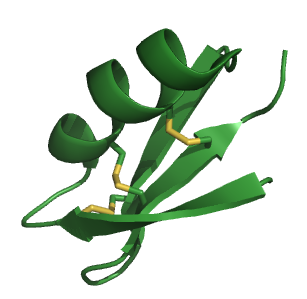
Charybdotoxin (CTX) is a 37 amino acid neurotoxin from the venom of the scorpion Leiurus quinquestriatus hebraeus (deathstalker) that blocks calcium-activated potassium channels. This blockade causes hyperexcitability of the nervous system. It is a close homologue of agitoxin and both toxins come from Leiurus quinquestriatus hebraeus. It is named after Charybdis, a sea monster from Greek myth.

Chlorotoxin is a 36-amino acid peptide found in the venom of the deathstalker scorpion which blocks small-conductance chloride channels. The fact that chlorotoxin binds preferentially to glioma cells has allowed the development of methods for the treatment and diagnosis of several types of cancer.

Maurotoxin is a peptide toxin from the venom of the Tunisian chactoid scorpion Scorpio maurus palmatus, from which it was first isolated and from which the chemical gets its name. It acts by blocking several types of voltage-gated potassium channel.

Margatoxin (MgTX) is a peptide that selectively inhibits Kv1.3 voltage-dependent potassium channels. It is found in the venom of Centruroides margaritatus, also known as the Central American Bark Scorpion. Margatoxin was first discovered in 1993. It was purified from scorpion venom and its amino acid sequence was determined.

Agitoxin is a toxin found in the venom of the scorpion Leiurus quinquestriatus hebraeus. Other toxins found in this species include charybdotoxin (CTX). CTX is a close homologue of Agitoxin.

Apamin is an 18 amino acid globular peptide neurotoxin found in apitoxin (bee venom). Dry bee venom consists of 2–3% of apamin. Apamin selectively blocks SK channels, a type of Ca2+-activated K+ channel expressed in the central nervous system. Toxicity is caused by only a few amino acids, in particular cysteine1, lysine4, arginine13, arginine14 and histidine18. These amino acids are involved in the binding of apamin to the Ca2+-activated K+ channel. Due to its specificity for SK channels, apamin is used as a drug in biomedical research to study the electrical properties of SK channels and their role in the afterhyperpolarizations occurring immediately following an action potential.
Tamapin is a toxin from the Indian Red Scorpion, which is a selective and potent blocker of SK2 channels.

Maurocalcine (MCa) is a protein, 33 Amino acid residues in length, isolated from the venom of the scorpion Maurus palmatus, which belongs to the family Chactidae, first characterized in 2000. The toxin is present in such small amounts that it could not be isolated to analyze it, so a chemical synthesis of this toxin was performed by the solid-phase technique so it could be fully characterized. It shares 82% sequence identity with imperatoxin A (IpTx A), a scorpion toxin from the venom of Pandinus imperator. IpTx A acts by modifying the activity of the type 1 ryanodine receptor of skeletal muscle. RyR controls the intracellular Ca2+ permeability of various cell types and is central in the process of excitation–contraction of muscle tissues. The synthesized toxin, sMCa is active on RyR1 and it binds onto a site different from that of ryanodine itself.
BmTx3 is a neurotoxin, which is a component of the venom of the scorpion Buthus Martensi Karsch. It blocks A-type potassium channels in the central nervous system and hERG-channels in the heart.
Discrepin (α-KTx15.6) is a peptide from the venom of the Venezuelan scorpion Tityus discrepans. It acts as a neurotoxin by irreversibly blocking A-type voltage-dependent K+-channels.

Lq2 is a component of the venom of the scorpion Leiurus quinquestriatus. It blocks various potassium channels, among others the inward-rectifier potassium ion channel ROMK1.
BeKm-1 is a toxin from the Central Asian scorpion Buthus eupeus. BeKm-1 acts by selectively inhibiting the human Ether-à-go-go Related Gene (hERG) channels, which are voltage gated potassium ion channels.
Hanatoxin is a toxin found in the venom of the Grammostola spatulata tarantula. The toxin is mostly known for inhibiting the activation of voltage-gated potassium channels, most specifically Kv4.2 and Kv2.1, by raising its activation threshold.
Butantoxin (BuTX) is a compound of the venom of three Brazilian and an Argentinean scorpion species of the genus Tityus. Butantoxin reversibly blocks the voltage-gated K+ channels Shaker B and Kv1.2, and the Ca2+-activated K+ channelsKCa 1.1 and KCa 3.1.
Spinoxin is a 34-residue peptide neurotoxin isolated from the venom of the Malaysian black scorpion Heterometrus spinifer. It is part of the α-KTx6 subfamily and exerts its effects by inhibiting voltage-gated potassium channels, specifically Kv1.2 and Kv1.3.
Pi4 is a short toxin from the scorpion Pandinus imperator that blocks specific potassium channels.

Noxiustoxin (NTX) is a toxin from the venom of the Mexican scorpion Centruroides noxius Hoffmann which block voltage-dependent potassium channels and calcium-activated potassium channels.
LqhIT2 is a long-chain scorpion depressant β-toxin derived from Leiurus quinquestriatus hebraeus. It targets insect voltage-gated sodium channels (Navs) and shifts the voltage dependence of channel activation to a more negative membrane potential.
BmP02, also known as α-KTx 9.1 or Bmkk(6), is a toxin from the Buthus Martensi Karsch (BmK) scorpion. The toxin acts on potassium channels, blocking Kv1.3 and slowing the deactivation of Kv4.2. BmP02 is not toxic to humans or mice.
LmαTX5 is an α-scorpion toxin which inhibits the fast inactivation of voltage-gated sodium channels. It has been identified through transcriptome analysis of the venom gland of Lychas mucronatus, also known as the Chinese swimming scorpion – a scorpion species which is widely distributed in Southeast Asia.









